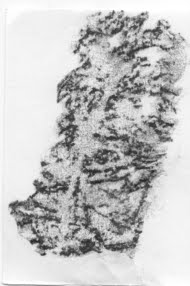Let's take a minute here at the beginning of this post to understand the difference between drawing and printmaking. Drawing is a direct process, one art work is produced. While an artist might make two drawings very similar, each work would be an individual art work made by hand. Printmaking is sometimes referred to as plate making. Here the art is created by first building a plate from some material such as wood , stone, plastic or metal. The plate is inked to produce the art work, which may be any number and each work is exactly the same.
The indigenous American artist probably did design these stones to be used as printing plates, however they mixed printing and drawing techniques in practice to produce beautiful effects. It is very likely that more than one art work might have been produced with a single plate. Through a process called “selective inking” only a portion of a particular plate was used to create an art work. When we observe the prints that appear here, we must take into account that the entire plate is visible, printed in one rub, these are documentary proofs of the entire plate structure.
You can reach me at ciaamuseum@gmail.com




















